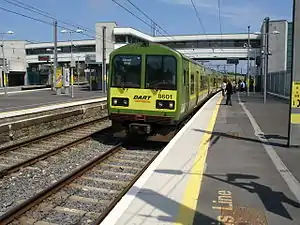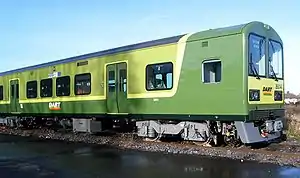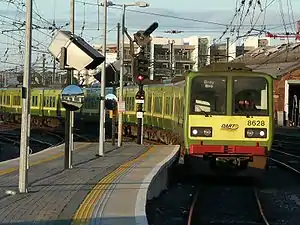IE 8500, 8510 and 8520 Classes
The Iarnród Éireann 8500, 8510 and 8520 Classes are three related types of EMU used on the DART network in Dublin, Ireland. The total fleet numbers a total of 17 four-car trains, all of which were constructed by the Tokyu Car Corporation.
| Iarnród Éireann 8500 Class | |
|---|---|
 8601 leads into Howth Junction | |
| In service | 6 July 2001 – present |
| Manufacturer | Tokyu Car Corporation |
| Family name | Tokyu Commuter |
| Constructed | 2000 |
| Number built | 4 trainsets |
| Formation | 4 cars per trainset: DT–DM–DM–DT |
| Fleet numbers | DM: 8501/8502 – 8507/8508 DT: 8601/8602 – 8607/8608 |
| Capacity | 160 seated |
| Operator(s) | DART |
| Specifications | |
| Maximum speed | 110 km/h (70 mph) |
| Electric system(s) | 1,500 V DC Overhead lines |
| Current collection method | Pantograph |
| Track gauge | 1,600 mm (5 ft 3 in) See Rail gauge in Ireland |
| Iarnród Éireann 8510 Class | |
|---|---|
 8614 shortly after delivery | |
| In service | 2 April 2002 – present |
| Manufacturer | Tokyu Car Corporation |
| Family name | Tokyu Commuter |
| Replaced | 8100 Class |
| Constructed | 2001 |
| Number built | 3 trainsets |
| Formation | 4 cars per trainset: DT–DM–DM–DT |
| Fleet numbers | DM: 8511/8512 – 8515/8516 DT: 8611/8612 – 8615/8616 |
| Capacity | 160 seated |
| Operator(s) | DART |
| Specifications | |
| Maximum speed | 110 km/h (70 mph) |
| Electric system(s) | 1,500 V DC Overhead lines |
| Current collection method | Pantograph |
| Track gauge | 1,600 mm (5 ft 3 in) See Rail gauge in Ireland |
| Iarnród Éireann 8520 Class | |
|---|---|
 8628 leads into Dublin Connolly | |
| In service | 17 September 2004 – present |
| Manufacturer | Tokyu Car Corporation |
| Family name | Tokyu Commuter |
| Constructed | 2003 – 2004 |
| Number built | 10 trainsets |
| Formation | 4 cars per trainset: DT–DM–DM–DT |
| Fleet numbers | DM: 8521/8522 – 8539/8540 DT: 8621/8622 – 8639/8640 |
| Capacity | 160 seated |
| Operator(s) | DART |
| Specifications | |
| Maximum speed | 110 km/h (70 mph) |
| Electric system(s) | 1,500 V DC Overhead lines |
| Current collection method | Pantograph |
| Track gauge | 1,600 mm (5 ft 3 in) See Rail gauge in Ireland |
8500 Class
The 8500 Class were delivered in 2000 and were the first four car units to be used on the DART network. They are numbered in the sequence 860X+850X+850Y+860Y. 850X/850Y units are power cars while 860X/860Y units are unpowered driving trailers. Their interior destination displays and public announcement system has been long turned off. Like all DART units, the 8500 Class are maintained at Fairview depot, and are also stabled at Bray Station.
8510 Class
The 8510 Class were delivered in 2001 as three 4-car trains supplementing the original 8500 Class. Vehicles are numbered in the sequence 861X+851X+851Y+861Y. 851X/851Y units are power cars while 861X/861Y units are unpowered driving trailers. The most visible difference between the 8510 Class and the 8500 Class is the now obsolete passenger information system which is installed in the 8510s. Other differences include the presence of destination/next station displays above the windows of 8510s and the use of LED tail lights and headlights on 8510s in contrast with ordinary ones on the 8500s. They are capable of operating in multiple with the 8500 and 8520 Classes The units are maintained at Fairview depot.
8520 Class
The 8520 Class was introduced in 2004; there are ten of these sets.[1] The units can be seen working in multiple with an 8500 or 8510 though usually with another 8520 unit. Vehicles are numbered in the sequence 862X+852X+852Y+862Y. 852X/852Y units are power cars while 862X/862Y units are unpowered driving trailers. They were the first units to carry the revised DART logo and also the first to be fully air conditioned. They can be distinguished from the previous 8500s and 8510s by the profile of the bodyshell, which is more rectangular, by the lack of opening windows in the passenger seating area and that the 8520s have flatter seats than the 8500s and 8510s.
Fleet details
| Class | Operator | Number | Year Built | Cars per Set | Unit nos. |
|---|---|---|---|---|---|
| 8500 Class | DART | 4 | 2000-2001 | 4 | 8601/8602 – 8607/8608 |
| 8510 Class | 3 | 2001-2002 | 8611/8612 – 8615/8616 | ||
| 8520 Class | 10 | 2003–2004 | 8621/8622 – 8639/8640 |
Accidents and incidents
- On 28 August 2019, an unidentified 8520 class unit failed between Dalkey and Glenageary. It is unknown if the unit was operating independently or in a set with another unit.
Gallery
 Unit 8633 at Inchicore Works shortly after delivery in 2004.
Unit 8633 at Inchicore Works shortly after delivery in 2004..jpg.webp) Connection between vehicles of unit 8633.
Connection between vehicles of unit 8633.
See also
| Wikimedia Commons has media related to IÉ 8500, 8510 and 8520 Classes. |
- Multiple Units of Ireland
- Dublin Area Rapid Transit
- IE 8200 Class